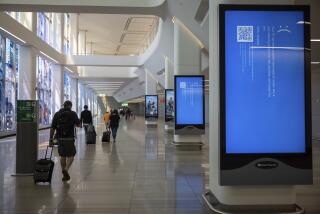Y2K Disruptions a Daily Ritual in Developing World
KALAYANPURI, India — As people in the world’s richest countries fretted that the new year would plunge them into disorder and darkness, residents of this grubby urban neighborhood had a hard time understanding all the fuss.
Here in Kalayanpuri, it’s Y2K every day.
Power blackouts? In Kalayanpuri, one of the innumerable quarters of the vast urban sprawl that is greater New Delhi, the electricity cuts off almost every day--sometimes for weeks at a time.
Water supply? Sometimes the tap water, if it flows at all, is poisonous. Every month, the neighborhood’s communal toilet backs up, pushing heaps of raw sewage into the streets.
Food supply? The shelves in the shops are nearly always full, but with refrigeration nonexistent, the meat and the vegetables often rot. Sometimes the whole neighborhood gets sick.
For Dinesh Goyal, a 40-year-old father of three who owns a pest-control business, the industrialized world’s worries about Y2K were irrelevant.
“Come and see the problems we have here, and then the people of the West will acquire much patience,” he said.
Kalayanpuri is part of the huge chunk of the world where nothing really works, anyway. There’s no point in worrying about blackouts because there is no electricity. And because there are no taps, there’s no running water.
Life Is a Hustle From One Calamity to Next
Of the world’s 6 billion people, only about half have electricity. About half have toilets. A third lack telephones. A billion people can’t get clean water, and the same number don’t get enough to eat.
In the great Third World cities, where modernity clings to the surface, breakdown is the norm and life is a hustle from one calamity to the next. Students study by candlelight, financial records vanish, patients die in operating rooms.
Dipen Ghosh said his mother, Lakshmi, died during routine gallbladder surgery in the eastern Indian city of Guwahati in 1998 because doctors accidentally severed an artery when the power went out. The doctors continued operating by candlelight but couldn’t save her.
“Our mother is not in our midst, and it is entirely because of the power failure,” Ghosh said.
Places like the tiny hamlet of Andargaon in eastern India are like Europe in the Middle Ages. In the 500,000 such villages across India that hold three-quarters of the country’s 1 billion people, life follows the movements of the sun, and half the villagers’ lives are cloaked in darkness.
“Dinner has to be ready by 7, so we can hit the bed by 8,” said Golapi Daimary, who lives in a mud-and-thatch roof hut with her husband and five children. “Everything has to be wrapped up by then.”
The nearest electrical connection is six miles away, but there is a school, and Daimary’s children do their lessons by candlelight.
“Sometimes I think our academic performance would be better if we studied under electric bulbs,” said Mohima, the eldest daughter.
Modern Services Are Often Disrupted
In the developing world’s largest cities, where much of daily life mimics that in the West, people’s lives are often disrupted by the collapse of modern services.
In Port-au-Prince, Haiti, entire neighborhoods depend on wells and rain for water. The phone system and traffic lights barely function.
Nairobi, Kenya, one of the leading cities of sub-Saharan Africa, experiences regular power rationing. When there are heavy rains, the power is almost certain to go out. Some telephone exchanges are incompatible, which means it is almost impossible to call from one to the other.
Kenyans aren’t concerned about Jan. 1, said Charles Ngothe, a 29-year-old insurance officer. “It will be like the other days of the year,” he said.
Even Russia, which has seen great industrial development, has problems all its own: Residents of Murmansk in the far north had no natural gas in November because authorities could not persuade anyone to deliver it. Roads collapse into boiling underground ponds caused by burst heating pipes. Power frequently goes off because of unpaid bills.
Two years ago, India’s thriving National Stock Exchange in Bombay shut down when one of the country’s main communication satellites lost power. The failed satellite knocked out television and telephone service in much of the country as well. It took three days for technicians to scurry around India to reprogram the stock exchange’s trading computers to work with another satellite. It was the third time the satellite had malfunctioned, this time for good.
“We lost $500 million,” said Satish Naralkar, a senior vice president with the stock exchange. “But people were sympathetic.”
Transportation is a constant headache.
In December 1998, hundreds of flights were canceled when the electronic landing system at New Delhi’s international airport failed to work properly during heavy fog. Last January, with the fog still thick, air traffic controllers also lost their radar systems, forcing them to land planes without instruments.
Three years ago, New Delhi air traffic controllers were accused of failing to follow proper procedures during a midair collision that killed 347 people.
Trains go hurtling down the wrong tracks all the time in India--but it is humans, not computers, who get the blame.
The Indian railway network, which carries 13 million passengers a day, has had 654 accidents that have killed more than 800 people all told in the past 18 months. The worst came in August, when a railroad crew accidentally switched the eastbound Awadh-Assam Express onto the same track as the westbound Brahmaputra Mail. The railway staff failed to notice the error, as did the drivers of the trains. The trains hurtled into each other, and nearly 300 people died.
“The engineer never woke up,” said V. P. Chandon of India’s Railways Ministry.
India Is No Stranger to Power Failures
In New Delhi, capital of a country with nuclear weapons and Nobel Prize winners, hardly a day goes by when the electricity doesn’t fail in much of the metropolis. During the infernal summers, when temperatures hover around 115 degrees, large sections of the city go for days without power. On any summer night, millions of people migrate to the streets--usually dragging their beds behind them--so they can sleep in the cooler air outside.
“In the summer, the children cry all the time,” said Raj Kumar Goyal, 31, a father of seven who owns a general store in the Kalayanpuri neighborhood.
Indian cities black out not because computers fail but because the demand for electricity outstrips supply.
About half of New Delhi’s electricity is stolen by people with illegal hookups, usually the city’s 3.5 million squatters. Theft and subsidized rates combine to prevent the government from raising enough money to build more power plants. So, experts say, blackouts in India will be longer and more frequent than ever.
When the juice does flow, a whole new set of electrical problems takes hold. Living in New Delhi is a daily drama of exploding appliances, short circuits and flaming fuse boxes. The city has about 15,000 fires a year--more than every major city in India combined--and electrical problems are blamed for two in every three.
When the electricity stops, so does the water. Municipal water flows into most New Delhi neighborhoods for only about two hours a day. There simply isn’t enough to go around. Even then, the pressure is so low that the water can’t make it into people’s homes.
To compensate, many homes in New Delhi employ electrical pumps that suck the water from the pipes and into huge rooftop storage tanks. With the aid of gravity, the water finally trickles into sinks and tubs. Without electricity, the pumps don’t work, so the water doesn’t flow.
“The smell in the neighborhood gets very bad,” said Goyal, the pest controller.
Officials in New Delhi say the city’s water supply network, built during the time of British rule, is on the brink of collapse. About 30% of the water is stolen or lost to holes in the pipes, many of which are also clogged up with silt. The holey pipes allow other pipes’ contents, such as raw sewage, to seep into the city water. The silt in the pipes also mixes with the water going through it. The result is a water network that often pumps poison into people’s homes.
“I want to get out of here,” said Pradip Mehra, chief executive officer of the Delhi Water Board, finally throwing up his hands after describing the city’s water crisis. “Why me?”
Anyone in New Delhi who can afford to do so installs a water purifier at home and cooks with bottled water.
For those who cannot afford it, the consequences can be lethal. In Bharat Vihar, a slum on the western fringe of the city, 11 people died in 1998 after drinking water provided by municipal authorities. The residents said they aren’t sure why the water killed so many people, but many added that they found a dead snake in the truck that had brought in the water.
“We’re afraid, but how can you survive without water?” shrugged Chotelal Pratham, a resident.
Delhites are a resilient bunch, and people here have found myriad ways to cope. In addition to water purifiers, many homes and factories have their own electrical generators that switch on automatically when the power fails. When the water dries up, private tankers rush to the neighborhoods.
Of all the people in New Delhi, those most insulated from Y2K-type maladies are those who stay in the city’s five-star hotels. Fancy ones like the Hyatt Regency employ huge generators, water purifiers and even their own wells that allow the hotels to operate independently of the city suppliers. “We’re just like a cruise ship,” said Arun Tandon, director of engineering at the Hyatt Regency Delhi.
Whatever happens in the West in the first days of 2000, the residents of the Bharat Vihar slum aren’t expecting much to change for them. They’re still waiting for electricity and fresh water, but they say they’ll get by without them.
“People in the West should face their problems with courage,” said Pratham, the Bharat Vihar resident. “We do every day.”
*
Times special correspondent Shankhadeep Choudhury in New Delhi, and staff writers Ann M. Simmons in Nairobi, Robyn Dixon in Moscow and Mark Fineman in Port-au-Prince contributed to this report.
More to Read
Sign up for Essential California
The most important California stories and recommendations in your inbox every morning.
You may occasionally receive promotional content from the Los Angeles Times.










